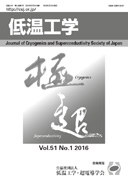
- |<
- <
- 1
- >
- >|
-
Takennori NUMAZAWA2016 Volume 51 Issue 8 Pages 375
Published: November 25, 2016
Released on J-STAGE: December 05, 2016
JOURNAL FREE ACCESSDownload PDF (596K)
-
– Working Process and Vacuum Techniques for Multiple-layer Insulation –Yasuharu KAMIOKA2016 Volume 51 Issue 8 Pages 376-383
Published: November 25, 2016
Released on J-STAGE: December 05, 2016
JOURNAL FREE ACCESSMultiple-layer Insulation (MLI) is essential for cryogenics. Without MLI, it is impossible to attain cryogenic temperatures. MLI is one of vacuum thermal insulations that requires a high vacuum to obtain enough performance. MLI working process is important to get high thermal insulation performance of a cryogenic system/device. In order to attain and maintain a good vacuum for MLI, a baking process is required to reduce the Out gas. Reduction of the Out gas is extremely important for maintaining a good insulation vacuum.
View full abstractDownload PDF (2294K)
-
Yoshikatsu HIRATSUKA2016 Volume 51 Issue 8 Pages 384
Published: November 25, 2016
Released on J-STAGE: December 05, 2016
JOURNAL FREE ACCESSDownload PDF (474K)
-
Kazuhiro HAMAGUCHI2016 Volume 51 Issue 8 Pages 385-390
Published: November 25, 2016
Released on J-STAGE: December 05, 2016
JOURNAL FREE ACCESSThe regenerator is an indispensable regenerative heat exchanger in Stirling cycle machines, G-M cryocoolers and pulse tube cryocoolers. Its existence is a key factor in enabling these machines to have the highest thermal efficiency and coefficient of performance. A regenerator is composed of a matrix and housing. The matrices are often made of stacks of fine wire mesh screens. However, an optimum balance between flow loss and heat transfer characteristics is required. In this report, based on the theoretical studies of thermal behavior in wire elements and matrices, relationships between design factors are obtained. An approach for designing regenerator used in Stirling cryocoolers is presented.
View full abstractDownload PDF (3096K) -
Shinji MASUYAMA2016 Volume 51 Issue 8 Pages 391-397
Published: November 25, 2016
Released on J-STAGE: December 05, 2016
JOURNAL FREE ACCESSRegenerative cryocoolers widely used for advanced applications, such as sensor cooling, superconducting systems and cryopumps, consist mainly of a compressor, regenerator and expander. A working fluid (generally helium gas) flows periodically in these main parts. The regenerator that is located between the compressor and expander is operated in a wide, lowtemperature range from 77 to 4 K, and a wide frequency range from one to a few hundred hertz. The regenerator is one of the most essential parts because its efficiency is directly linked to the performance of the cryocoolers. Therefore, understanding the properties of regenerators (including regenerator material) and helium are important. In this paper, the thermodynamic efficiency of a regenerator, and the temperature dependence of the specific heat of regenerator materials and pressurized helium are presented. Furthermore, several types of simulated temperature and specific heat (heat capacity) distributions within a 4 K regenerator are shown to clarify the intriguing effect of magnetic regenerator materials.
View full abstractDownload PDF (891K)
-
Haruki ISHII, Daisuke BOUZAWA, Kazuhiro HAMAGUCHI2016 Volume 51 Issue 8 Pages 398-402
Published: November 25, 2016
Released on J-STAGE: December 05, 2016
JOURNAL FREE ACCESSWe introduce the basic characteristics of a high-porosity sintered metal fiber (SMF) matrix for the regenerator that plays a key role as a thermal storage regenerative heat exchanger in Stirling cycle machines. We measured the basic characteristics of flow resistance and heat transfer in a comparison with a stacked wire-mesh matrix. The results of our experiment show that the heat transfer characteristics of a SMF matrix is equivalent to that of a stacked wire-mesh matrix, whereas the pressure drop in a SMF matrix is lower than that in a stacked wire-mesh matrix under the condition of equivalent specific surface area. Using the measurement data, we obtained the relational expression between the Nusselt and Reynolds numbers, and between the friction factor and Reynolds number for each porosity level of the SMF matrix. The estimation of COP using a simple Schmidt model shows the positive performance of the SMF matrix.
View full abstractDownload PDF (2818K)
-
Yuki UEDA, Irna FARIKHAH2016 Volume 51 Issue 8 Pages 403-408
Published: November 25, 2016
Released on J-STAGE: December 05, 2016
JOURNAL FREE ACCESSA simple numerical method to calculate the performance of a stacked-screen regenerator is proposed. The method is based on a well-known thermoacoustic theory but uses some empirical factors that were determined by the measurement of viscous losses in stacked-screen regenerators. The efficiency of the energy conversion in a stacked-screen regenerator is calculated using the method and compared with the experimental results. Furthermore,a comparison of the numerically calculated efficiencies in stack-screen and tube-array regenerators is performed.
View full abstractDownload PDF (836K)
-
Jun-ichi SHIMOYAMA2016 Volume 51 Issue 8 Pages 409-410
Published: November 25, 2016
Released on J-STAGE: December 05, 2016
JOURNAL FREE ACCESSDownload PDF (1033K)
- |<
- <
- 1
- >
- >|